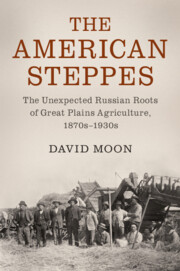Book contents
- The American Steppes
- Studies in Environment and History
- The American Steppes
- Copyright page
- Dedication
- Epigraph
- Contents
- Figures, Maps, and Tables
- Preface
- Acknowledgements
- Notes on the Text
- Dramatis Personae
- Abbreviations
- Maps
- Introduction
- Part I Contexts
- Part II Transfers
- Conclusion
- Archival Collections Cited
- Index
Conclusion
Published online by Cambridge University Press: 23 March 2020
- The American Steppes
- Studies in Environment and History
- The American Steppes
- Copyright page
- Dedication
- Epigraph
- Contents
- Figures, Maps, and Tables
- Preface
- Acknowledgements
- Notes on the Text
- Dramatis Personae
- Abbreviations
- Maps
- Introduction
- Part I Contexts
- Part II Transfers
- Conclusion
- Archival Collections Cited
- Index
Summary
The Conclusion considers the legacies of the “Russian roots” of Great Plains agriculture down to the present day as well as tying together the argument. Attention is paid to the differences between the environments and environmental histories of the two regions: The climate of the steppes is generally slightly harsher than the Great Plains due in part to the different orientations (E–W and N–S) of the two regions and the agricultural settlement of the steppes began several decades prior to that of the Great Plains. Thus, crops that could cope with the extremes of the climate in the steppes could survive all but the most extreme fluctuations in the Great Plains. And, there was prior experience in the steppes of the Russian Empire and Soviet Union that Americans could draw on.
- Type
- Chapter
- Information
- The American SteppesThe Unexpected Russian Roots of Great Plains Agriculture, 1870s–1930s, pp. 382 - 417Publisher: Cambridge University PressPrint publication year: 2020

